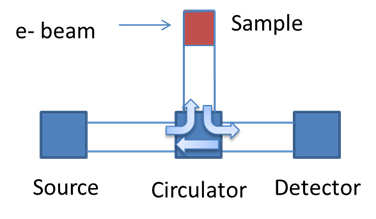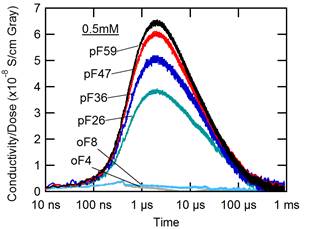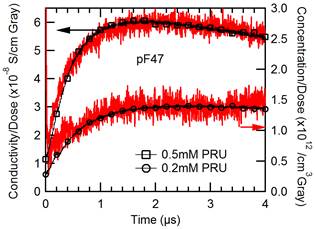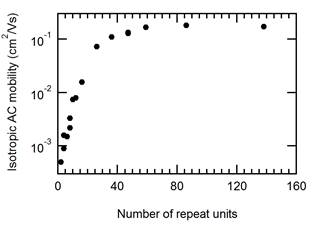- Home
-
Research Groups
Division Groups
- Artificial Photosynthesis
- Catalysis: Reactivity & Structure
- Electrochemical Energy Storage
- Electron- and Photo-Induced Processes for Molecular Energy Conversion
- Neutrino and Nuclear Chemistry
- Surface Electrochemistry and Electrocatalysis
Associated Groups
- Catalysis for Alternative Fuels Production
- Nanostructured Interfaces for Catalysis
- Structure and Dynamics of Applied Nanomaterials
- People
- Operations
- News
- Events

Electron- and Photo-Induced Processes
Pulse-Radiolysis Time Resolved Microwave Conductivity (PR-TRMC)
The propagation of microwaves through solids, liquids and gases will be affected by the presence of mobile charges. Depending on the microscopic environment (scattering rate, confinement of charge on short or coiled objects), this can lead to absorption of microwaves and/or a lengthening or shortening of their wavelength. These effects can be related to changes in the complex high frequency dielectric constant or equivalently the complex AC conductivity. To study the conductivity of charge carriers along various long molecules we must create some charges in an otherwise low-loss medium i.e. a low dielectric constant solvent or matrix within a waveguide section. This could be done through optical excitation or pulse radiolysis and is shown schematically in figure1.
Pulse radiolysis uses a short pulse of high energy electrons to ionize a medium, kicking off secondary electrons as they propagate and leaving behind positive ions. Many of these ionizations result in charge pairs that will not be able to escape each other’s Coulomb attraction and will recombine rapidly (ps-ns) in a process known as a geminate recombination. Some, however, will be created at such a distance (>~30nm) that they are free from each other’s influence and will last for tens to hundreds of microseconds as they undergo bimolecular recombination. Such charges, generated in a solvent, will in time, attach to any solute molecules. A second solute can be added to selectively prevent either holes or electrons from attaching to the polymers enabling both conductivities to be determined separately. As the mobility of charges along conjugated polymers is much larger than that of the solvent ions, the transferal of charge will result in an increase in the AC conductivity of the solution as shown in figure 2 for various length polyfluorenes.1
While the conductivity per unit dose of radiation (from high energy electrons) can be determined accurately based on known equations for the propagation of microwaves in waveguides filled with a conductive medium, the conductivity per charge, which is essentially the mobility, requires knowledge of the concentration of charges produced for a given dose of radiation. This can be modeled by fitting transients like those in figure 2 to a series of differential equations given knowledge of the yield of free ions expected in a given solvent and the rates of transfer between the various species present, or it can be determined more directly by transient optical absorption (PR-TAS) from the charged molecules when their extinction coefficients are known. Figure 3 shows and example of both microwave conductivity and optical absorption transients per dose of radiation.
Finally, with the conductivity per unit dose and concentration per unit dose, the mobility can be established. Figure 4. shows an example of the AC mobility measured for a variety of different length oligo- and polyfluorenes. While the actual mobility of charges along the polymer backbone is expected to be almost independent of length, the measured mobility shows a length dependence due to charges encountering the ends during one microwave period. The mobility will increase with length and saturate when end effects become negligible although in practice is limited at a shorter length due to polymer coiling and/or defects.
References
1Bird, M. J.; Reid, O. G.; Cook, A. R.; Asaoka, S.; Shibano, Y.;
Imahori, H.; Rumbles, G.; Miller, J. R., Mobility of Holes in Oligo- and
Polyfluorenes of Defined Lengths. The Journal of Physical Chemistry C
2014, 118, 6100-6109.

Figure 1. Simplified schematic diagram of the waveguide configuration for PR-TRMC measurements

Figure 2. Conductivity transients measured with PR-TRMC on a variety of different
length oligo- and polyfluorenes in benzene with a concentration of 0.5mM polymer repeat units.

Figure 3. Overlay of dose-normalized conductivity and polymer charge concentration
derived from PR-TRMC and PR-TAS respectively on a polyfluorene solution with
average length 47 repeat units.

Figure 4. AC mobility at 9GHz for positive charge carriers on oligo- and polyfluorenes of
various lengths in benzene.




